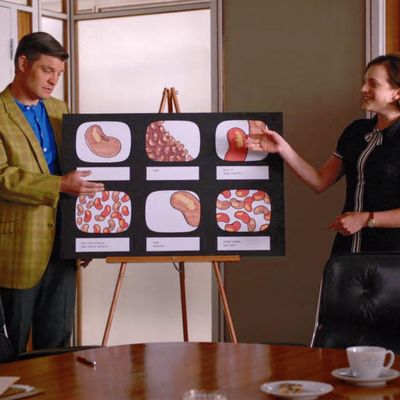
There’s an episode of Mad Men I’ve been thinking about lately in which Peggy, tasked with creating an ad campaign for Heinz beans, takes the opportunity to pitch something particularly artful: a bean ballet. She envisions a microphotography camera zooming in on individual beans pirouetting in slow motion, beans somersaulting and spinning, all set to a classical string melody. The Heinz executive isn’t impressed. It’s all too high-concept, plus, beans look pretty gross up close. He wants to know what the viewer will even take away from it. “It puts beans on their mind,” Peggy answers. “Believe it or not, it makes them exciting.”
These days, Peggy likely wouldn’t have faced so much pushback. Beans, it seems, are on everyone’s minds. In 2018, The New Yorker published a 7,000-word deep dive on heirloom varieties. A spiced chickpea and coconut-milk dish from cook and writer Alison Roman known simply as #TheStew became Instagram’s most viral recipe over the winter. Model and cookbook author Chrissy Teigen has gone on the record tweeting missives like, “I am a big fan of beans,” and, “bush’s baked beans > nutella.” My personal bean revelation came a few years ago. One night, while simmering a potful of them for dinner, a voice broke through my bean-induced reverie and forced me to confront a profound, latent inner truth. Beans, I realized, are probably my favorite food.
It was a relief of sorts to finally admit this to myself, to admit that I’m the type of woman who regularly tucks into a big bowl of beans. See, beans contain multitudes: They’re sturdy, reliable, versatile, an affordable vegetarian protein source. But beans, no matter how you slice them [Ed. note: I do not recommend slicing beans] are not typically considered cool. For most of my life, I had two primary associations with them: the staple ingredient in the Egyptian food I grew up eating, and farts.
Now, cool or not, we collectively can’t get enough of beans. The Wall Street Journal reports that they’re one of the fastest growing and most popular ingredients in new food products. “Everything about a bean is fashionable,” declared Lu Ann Williams, the director of innovation at Innova Market Insights, a firm that tracks food and beverage trends. (I may be a woman who can confidently admit that I love beans, but what I truly long to be is a woman who can confidently proclaim, “Everything about a bean is fashionable!”) A recent article in The Atlantic looked more closely at the rise of the chickpea in America, shepherded in through items like store-bought hummus and aided by people’s conscious desire to eat less meat. Eating beans instead of beef, we’re even told, could save the world.
When I brought up beans in the Cut’s Slack channel, I was met by an onslaught of bean enthusiasm from my colleagues. Writer Kelly Conaboy shared her aunt’s friend’s secret recipe for a “bean meal,” which is, “Just dump a can of beans into a pot and heat it up.” “Beans are perfect. They are delicious, and they combine protein and fiber in a way that is truly unparalleled. Every cuisine in the world uses beans because they are the One True Superfood,” writer Hayley Schueneman told me. “Also everyone who just associates beans with farting needs to grow the fuck up.” (Writer Opheli Garcia Lawler boldly came out as one of the lone dissenters. “All beans feel like dirt in my mouth,” she said. “I hate it, and it automatically triggers my gag reflex. Despite the threat of shame from my peers and my family, I’ve never been able to change my stance on beans, which is that they are not good.” I’m not mad, just disappointed.)
“I love beans,” editor Jen Gann added.
Bean love has also cropped up in certain glamorous spheres. I did a double-take when I saw popular style blogger Jane Aldridge of Sea of Shoes tweet, “I’ve replaced my urge to buy new stuff with the urge to cook beans. It works. I always have lots of beans soaking in water waiting to be cooked into something delicious. Always thinking about my beans.”
As I, too, am someone who’s always thinking about my beans, I called Aldridge up to hear more. She told me that she got on the bean-soaking train after having to alter her diet for health reasons, taking advice from Amy Chaplin’s At Home in the Whole Food Kitchen. It provided her with more than just gastronomic satisfaction. “It was very therapeutic,” Aldridge told me. “I KonMari’ed my life at the same time I made this big lifestyle change. I was like, ‘I’m not letting anything in,’ so I just got really into my kitchen ritual, having the beans soaking.”
As with all popular things, there is some sexuality being infused into the bean discourse. Take the video released last August by Love magazine of model HoYeon Jung joyously and seductively rubbing beans all over her face, beaming as she slurps them off her hands.
Rachel Rabbit White wrote of the implicit eroticism of beans in Brokeback Mountain for Garage magazine. Liara Roux, a sex worker and organizer, hosted a sex party last month that involved kiddie pools full of baked beans. It was thrown, in part, for a friend who’d had a bean fetish since they were a teen. “We used cannelinis and we used some very pretty reddish lima beans with white streaks on them. We soaked the beans overnight and then cooked them,” Liara told me. “We wanted some of the beans to be really mushy but we wanted some of them to be more firm and juicy. So we had a variety of bean textures.”
“It was really hot,” they continued. “I was coated in beans. It felt really sensual.”
While the rest of us may never be ready to take our relationship with beans to that level, at least we can agree: It’s bean time, all the time.


